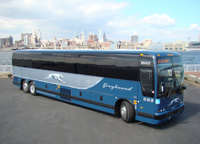Editorial
Front Page - Friday, February 11, 2011
Bus service still popular for intercity travel, Greyhound says
David Laprad
 “Look at that thing: fast as a greyhound!” an early bus driver is believed to have said to a friend about the iconic motor coaches. Although the nostalgic glow of bus travel has faded somewhat, its use as a popular mode of transportation has not, with newer busses offering several surprising amenities, including Wi-Fi service.
- Photo provided
“Look at that thing: fast as a greyhound!” an early bus driver is believed to have said to a friend about the iconic motor coaches. Although the nostalgic glow of bus travel has faded somewhat, its use as a popular mode of transportation has not, with newer busses offering several surprising amenities, including Wi-Fi service.
- Photo provided
There was a time when taking a trip on a bus was as much a part of Americana as a Norman Rockwell painting. Sleek silver Greyhounds rolling past fields of corn, traveling over tree-covered hills and stopping at mom and pop cafes were a part of the American lexicon.
Children were able to ride alone to see grandpa and grandma, strangers would become acquainted with each other as the miles passed, and ticket prices never raised an eyebrow. Bus travel was a rite of passage for adolescents, and the transportation of choice for people who wanted to go where there were no airports or train stations.
The busses are still out there, as are the fields of corn and tree-covered hills. But what about the passengers? Have they abandoned bus travel for other modes of transportation?
Actually, Greyhound’s busses are still packed, to the tune of 20 million passengers per year. But instead of talking with seatmates or admiring the scenery, many passengers bury their noses in their laptops, thanks to the company’s new Wi-Fi service.
The times have certainly changed the leading bus line in the country, but some things have remained the same, says Tim Stokes, Greyhound representative.
“As an important icon in the transportation industry, Greyhound has evolved in many ways. What hasn’t changed is our commitment to providing safe and affordable transportation services to the public.”
Some of the amenities that weren’t around when grandpa was riding Greyhound are the option to purchase tickets online and via a mobile phone. Also, Greyhound is running new motor coaches in the Midwest and Northeast with a new design, a new color scheme and new amenities. The new and refurbished coaches provide leather seating, power plug-ins for electronic devices, and the aforementioned ability to connect to the World Wide Web.
“We’re adapting to what our customers are finding beneficial in their everyday life, as well as when they travel,” Stokes says.
As Greyhound has updated its amenities, it’s continued to offer convenient scheduling, affordable prices and a safe experience, Stokes says.
“Our drivers go through some of the most extensive training to ensure we’re providing our customers the safest form of transportation when they travel with us. Drivers complete more hours of training before operating one of our coaches than any other transportation provider in the industry,” he says.
Moreover, Greyhound has made massive changes to its procedures since the September 11, 2001 terrorist attacks to increase safety and lower risk. Stokes says the company’s security plan addresses all Department of Homeland Security terror alert levels.
“The most important measure we’ve taken is to aggressively enforce our zero tolerance policy with respect to unruly or aggressive passengers. Threatening behavior – even displayed as humor – will be taken as a serious offense.
“We also implement random wanding, conducted by our security teams, at various Greyhound stations. Our terminal employees and drivers have heightened sensitivity to suspicious behaviors and prohibited items. They’ve also been trained to notify local law enforcement authorities if they observe any suspicious activities or unaccompanied packages,” Stokes says.
That’s no small task, given that Greyhound is one of the largest providers of intercity transportation, serving 3,800 destinations with 15,000 daily departures across North America. But they are necessary steps for the company, which claims the safety of its employees and customers is its core value.
Greyhound has also been challenged to keep its ticket prices affordable as gas prices have risen. But Stokes says higher expenses across the transportation industry have made it imperative for Greyhound to control the cost of traveling on its busses.
“We’re becoming a more intriguing travel option for customers given the state of the economy and our customers’ need to use money more wisely and receive the biggest return on their purchase.”
According to an article titled “History of the Greyhound Bus Company,” by Judy Tomlinson, Greyhound bus transportation can be traced to a young Swedish immigrant’s distaste for his job in a Minnesota mine. In 1913, the immigrant, named Carl Earl Wickman, bought a Hupmobile agency in Hibbing, Minn., and began transporting miners to work in another town for 15 cents. The Northland Bus Lines absorbed several other lines in the late 1920’s to become Greyhound.
Although various stories about how the company’s coaches came to be associated with greyhounds exist, one of the more popular tales has an early bus driver remarking to a friend as they watched one of its coach speed by, “Look at that thing: fast as a greyhound!”
Greyhound will likely experience many changes over the next 100 years, but Stokes is certain two things will stay the same: “Our customers will continue to enjoy the ability to view the open road and meet new people who are traveling with us.”
That is, if they can keep their noses out of their laptops.
|
|